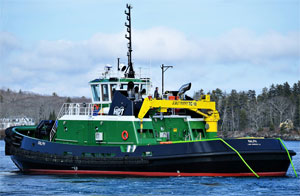Harbor Docking & Towing Capt. Scott Lantier eased Ralph off Washburn & Doughty’s dock and steered south in the Damariscotta River. The main engines stayed silent as the tugboat climbed to 8 knots against a 3-foot swell.
Down in the engine room, a single Caterpillar C18 engine provided electric power for motors mounted aft of the z-drives. A second C18 automatically fired up as Lantier requested more power, and an internal control system equalized the load between the two engines.
“I am impressed with it so far,” Lantier said as he stared south toward open water, “especially with the electric mode. It’s very smooth.”
Washburn & Doughty built Ralph and sister vessel Capt. Robb at its East Boothbay, Maine, shipyard. Both are based on the yard’s proven 93-foot hull form, albeit with notable changes to the engine room, exhaust stacks and interior layout. The tugs are Subchapter M certified and meet EPA Tier 4 emissions standards.
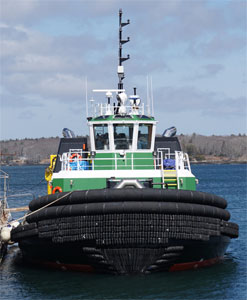 |
|
Ralph is the first of Washburn & Doughty’s 93-foot hull designs with hybrid propulsion. |
The vessels are the first in the U.S. with Caterpillar’s hybrid technology. The system uses three generators to create electricity to run an electric thruster motor installed aft of each z-drive. Propulsion can come from the main engines, the diesel-electric gensets or with both systems simultaneously for maximum power. Bollard pull exceeds 84 metric tons.
Harbor Docking, based in Lake Charles, La., operates eight tugboats that typically handle big tankers calling the region’s refineries and petrochemical plants. Its vessels often travel 45 minutes or more to meet incoming ships. Fuel and maintenance costs from these transits add up quickly.
For its new tugboats, Harbor Docking wanted vessels that were reliable, efficient and as environmentally friendly as possible, President John Buchanan said. They also wanted to reduce fuel consumption and long-term maintenance costs without sacrificing power. Several engine makers responded to that concept, but Caterpillar’s hybrid system checked all the boxes.
“We typically build high-horsepower tugs, and in doing so wanted to take advantage of the new technology in the market and kind of push the envelope a little bit,” he said.
“We envision it transiting to and from a job on diesel-electric power with the main engine completely shut down,” Buchanan continued. “We’ll be saving running hours and saving fuel. Then when we arrive at the job, you basically push a button to transition to the power mode where the main engines and generators are providing thrust.”
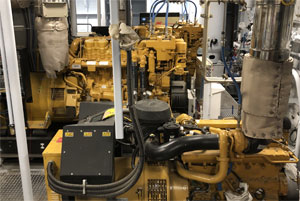 |
|
Two Cat C18 gensets and a single C7.1 unit supply power to ABB electric thruster motors for hybrid propulsion. |
Harbor Docking also plans to offer launch services with Ralph and Capt. Robb, filling a mostly unmet need around Lake Charles. The aft deck is large enough to accommodate a 20-foot shipping container that could be filled with parts, groceries and other needs. An EBI TC10 crane will do the heavy lifting between vessels.
“As we were building new tugs, we thought about what other value-added services a harbor tug company could provide,” Buchanan said. “We think a logical one is some sort of launch service.”
Hybrid tugboats are still something of an anomaly in the United States more than a decade after Foss built Carolyn Dorothy, the first U.S. hybrid tugboat, for service on the West Coast. That technology functioned a lot like a hybrid vehicle with battery banks to store power for propulsion in low-load situations. The batteries are heavy, take up space and can create some challenges that must be mitigated by the crew.
Cat’s system does not include batteries or power storage. Instead, it relies on two 565-kW C18 gensets and a single 200-kW C7.1 genset to provide on-demand electrical power. The system also includes a fully integrated control panel, switchgear and variable frequency drives. A main clutch is located between the main engines and the z-drives.
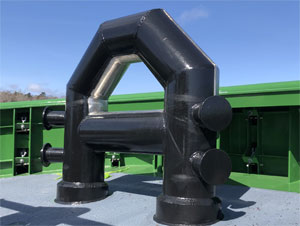 |
|
Washburn & Doughty crews built the robust bow staple on Ralph and its sister tug Capt. Robb. |
In simple terms, the system directs power to the z-drives in two ways. One is through a traditional shaft line from the main engines. The other is from one or more gensets supplying current to the electric thruster motors. These systems can run together or separately. Although the twin Cat 3512E mains generate 5,100 total horsepower, the electric motors add about 800 hp each for total onboard power of 6,700 hp.
Four operational modes can be selected by pressing a single button to determine which engines turn the z-drives. Running electric mode with just the ABB thruster motors, Ralph can reach 10 knots in calm conditions. Diesel mode runs just the main engines, while hybrid mode runs both the mains and gensets. The gensets run up to about 90 percent load to reserve power for ship service.
The fourth is a FiFi mode that uses electric motors for propulsion or stationkeeping while the starboard main engine drives the FFS fire pump. Two aft-mounted FFS 1200 remote-controlled monitors are operated from a panel in the wheelhouse.
The electric motors offer the additional benefit of immediate thrust, Buchanan said, noting that even high-speed engines have a momentary lag while they spool up. “This is set up so basically as soon as you throw current at the electric motor, you have thrust.”
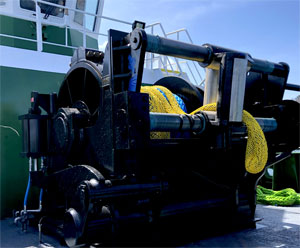 |
|
Markey’s DEPCF-52 hawser winch is spooled with 475 feet of 10-inch Samson AmSteel-Blue line. |
Electric steering motors on the drives also are more responsive than traditional units. Capt. Lantier said Ralph can spin 360 degrees in about 20 seconds, compared to about 25 with the company’s other tractor tugs. Lantier is a lead captain for Harbor Docking who previously served as captain of the tractor tug Pat built in 2013 at Main Iron Works.
Washburn & Doughty has built 19 of its 93-foot tugboats, including a handful of Tier 4 models. The design has proven itself repeatedly in escort and docking work. That was part of the appeal for Harbor Docking. “I love the performance the 93-footer provides,” Buchanan said, noting that it matches up against just about any design out there. “It really is a solid tug all the way around as far as performance, design and capability.”
The shipyard’s naval architects made some significant changes to its 93-foot hull to accommodate hybrid system components. One change placed a bulkhead in the engine room to separate engines from the sensitive electronics installed aft of the main engine space. Another placed the selective catalytic reduction (SCR) units vertically in the stacks rather than over the engines as seen in other Tier 4 tugs.
“We saw a lot of heat generation from that (placement),” said Justin Clark, vice president of operations support at Washburn & Doughty. “This time we made the stacks a little bigger and we were able to put the SCR up into the stacks … where there is more space.”
Moving the SCR units also simplified construction by reducing the amount of piping in the engine room, Clark said. Dinak insulated stainless-steel exhaust pipes that are warm to the touch, rather than nearly 700 degrees, further reduce heat on the vessel.
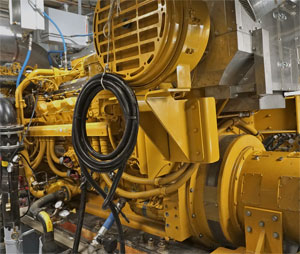 |
|
Caterpillar 3512E Tier 4 engines each generate 2,550 hp. |
Both tugs will operate with a four-person crew, giving each person their own room. Those cabins each will have their own climate controls to allow crews to keep cool during the blazing South Louisiana summers. Other crew amenities include wireless Internet accessibility, and vibration- and sound-dampening materials installed throughout.
The wheelhouse features W&D’s standard layout with large windows and 360-degree views. Cat touch-screen controls are embedded in control panels on both sides of the helm chair, along with Furuno navigation electronics and displays. Simrad supplied the autopilot and satellite compass.
Towing will take place off the bow, where a 75-hp Markey electric hawser winch occupies the foredeck along with a shipyard-built staple painted a crisp black. The aft deck has towing bitts on the port and starboard side in addition to an emergency tow line should the need arise. The winch is spooled with 475 feet of 10-inch line.
From bow to stern, the deck is lined with an aggressive poured non-slip coating commonly found on naval vessels. Viking supplied the protective rubber fenders.
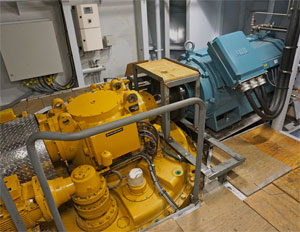 |
|
Blue ABB thruster motors can work in tandem with the main engines for maximum power or separately when less thrust is needed. |
Back on the Damariscotta River, Capt. Lantier followed commands from Peter Grant, who was on board working to calibrate the Ritchie magnetic compass. Lantier was unfazed by the new hybrid controls and various modes at his disposal. “Driving the boat is still the same,” he said. “It’s just learning the system.”
Ralph, named for Ralph Hill, a longtime Harbor Docking board member, was still undergoing trials as of late April. Meanwhile Capt. Robb, named for Captain Bill Robb, was launched April 18, and is due for delivery this summer.
Early results during trials suggest the decision to install the hybrid propulsion system will literally pay off. One recent transit in electric mode, for instance, burned about 23 fewer gallons of diesel per hour than a comparable trip on main engines. That’s exactly the performance Buchanan was hoping for.
He had high praise for the shipyard and said their craftsmanship, combined with positive results during sea trials, reinforced the decision to install hybrid propulsion. “From an owner’s perspective, we were a little nervous,” he admitted. “But after we completed the builder trials and got some preliminary numbers, we are way more optimistic and excited.”

